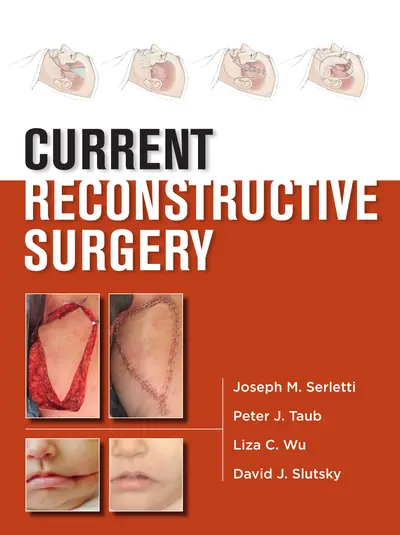My Account Details

ISBN10: 0071477233 | ISBN13: 9780071477239

Step 1 . Download Adobe Digital Editions to your PC or Mac desktop/laptop.
Step 2. Register and authorize your Adobe ID (optional). To access your eBook on multiple devices, first create an Adobe ID at account.adobe.com. Then, open Adobe Digital Editions, go to the Help menu, and select "Authorize Computer" to link your Adobe ID.
Step 3. Open Your eBook. Use Adobe Digital Editions to open the file. If the eBook doesn’t open, contact customer service for assistance.
Publisher's Note: Products purchased from Third Party sellers are not guaranteed by the publisher for quality, authenticity, or access to any online entitlements included with the product. Full-color, step-by-step guidance on reconstructive procedures Authored by top experts in the field, Current Reconstructive Surgery is a comprehensive resource that prepares you for the most challenging cases, while giving you a solid grasp of the fundamentals. The content of the book—logically organized by anatomic region—is supported by more than 1,300 state-of-the-art illustrations and photographs, nearly all of which are in full color. Current Reconstructive Surgery begins with a valuable review of the principles of wound healing and wound repair. Its subsequent chapters meticulously examine pertinent reconstructive topics and present the latest surgical protocols for all injuries and disabilities, from burn reconstruction and skull base surgery to the management of hand infections. Current Reconstructive Surgery delivers insights derived from the authors’ vast experience as practitioners, combined with data from new and landmark studies. This one-of-a-kind guide has everything you need to confidently perform both common and uncommon reconstructive procedures—so you can improve function and approximate a normal appearance for your patients. Each chapter covers: Patient evaluation and selection: Proven diagnostic strategies that elucidate the nature of the disorder, including onset and duration Patient preparation: Details the preoperative plan, including anesthesia considerations, grafts or flaps used in reconstruction, and patient positioning Techniques: Evidence-based surgical approaches for each type of surgery Incisive coverage of postoperative management: Important steps that physicians and patients must take to promote healing and restore function Overview of complications: Such as infection, fistulae, the risk of secondary procedures due to unsatisfactory results, and post-surgical psychological problems related to the patient’s self-image
1. The Principles of Wound Healing
2. Techniques of Wound Repair
3. Transplant Biology
4. Tissue Expansion
5. Alloplastic Implants
6. Anesthesia
7. Skin and Angiosomes
8. Fasciocutaneous Flaps
9. Muscle Flaps
10. Principles of Microvascular Surgery
11. Perforator Flaps
12. Peripheral Nerve Repair, Grafts
Part II:Integument and Soft Tissue
13. Basal Cell and Squamous Cell Carcinoma
14.Malignant Melanoma
15.Congenital Melanocytic Nevi
16. Hemangiomas
17.Vascular Malformations
18.Benign Lesions/General Skin Disorders
19.Thermal, Electrical, Chemical Injuries
20.Burn Reconstruction
Part III:Head and Neck
21. Head and Neck Embryology
22.Presurgical Orthopedics
23.Unilateral Cleft Lip
24.Bilateral Cleft Lip
25. Cleft Palate
26. Velopharyngeal Insufficiency
27.Alveolar Bone Grafting
28. Cephalometic Analysis
29.Facial Form Analysis
30.Secondary Cleft Deformities
31.Craniosynostosis
32.Hemifacial Microsomia
33.Craniofacial Clefts
34.Surgery of the Jaws
35. Orbital Deformities
36.Skull Base Surgery
37.Soft Tissue Injuries of the Face
38.Pediatric Facial Fractures
39.Frontal Sinus Fractures
40.Nasal Fractures
41.Orbital Fractures
42.Zygomaticomaxillary Complex Fractures
43.Maxillary and Midface Fractures
44.Mandibular Fractures
45.Panfacial Fractures
46.Reconstruction of the Ear
47.Reconstruction of the Nose
48.Reconstruction of the Lips
49. Cheek Reconstruction
50. Eyelid Reconstruction, Ptosis Surgery
51.Scalp, Calvarial, Forehead Reconstruction
52.Head and Neck Cancer
53.Intraoral Tumors and Neck Dissection
54Intraoral Reconstruction
55.Mandibular Reconstruction
56.Otoplasty
57.Reconstruction of the Paralyized Face
58.Treatment for Baldness
Part IV:Breast
59.Breast Cancer
60.Implant Breast Reconstruction
61. Autogenous Breast Reconstruction
62.Reduction Mammaplasty
63.Gynecomastia
64.Congenital Breast Disorders
Part V:Hand and Upper Extremity
65. Physical Examination of the Hand
66.Radiologic Imaging of the Hand
67.Soft Tissue Recon of the Upper Ex
68.Fractures and Dislocations of the Hand
69.Fractures and Dislocations of the Wrist
70.Extensor Tendon Injuries
71. Flexor Tendon Injuries
72.Finger tip and Perionychium
73.Infections of the Hand
74.Nerve Repair of the Upper Extremity
75.Nerve Compression Syndromes
76.Replantation and Revascularization
77.Thumb Reconstruction
78.Tendon Transfers
79.Congenital Hand Anomalies
80.The Mutilated Hand
81.Brachial Plexus
82.Rheumatoid and Osteoarthritis
83.Dupuytren’s Disease
84.Tumors of the Upper Extremity
85.Tenosynovitis
86.Rehabilitation of the Injured Hand
Part V:Trunk and Lower Extremity
87.Chest Wall Reconstruction
88.Abdominal Wall Reconstruction
89.Reconstruction of the Posterior Thorax
90.Lower Extremity Reconstruction
91.Pressure Sores
92.Lymphaedema
93.Foot and Ankle Reconstruction
94.Leg Ulcers
95.Reconstruction of the Genitalia
Need support? We're here to help - Get real-world support and resources every step of the way.